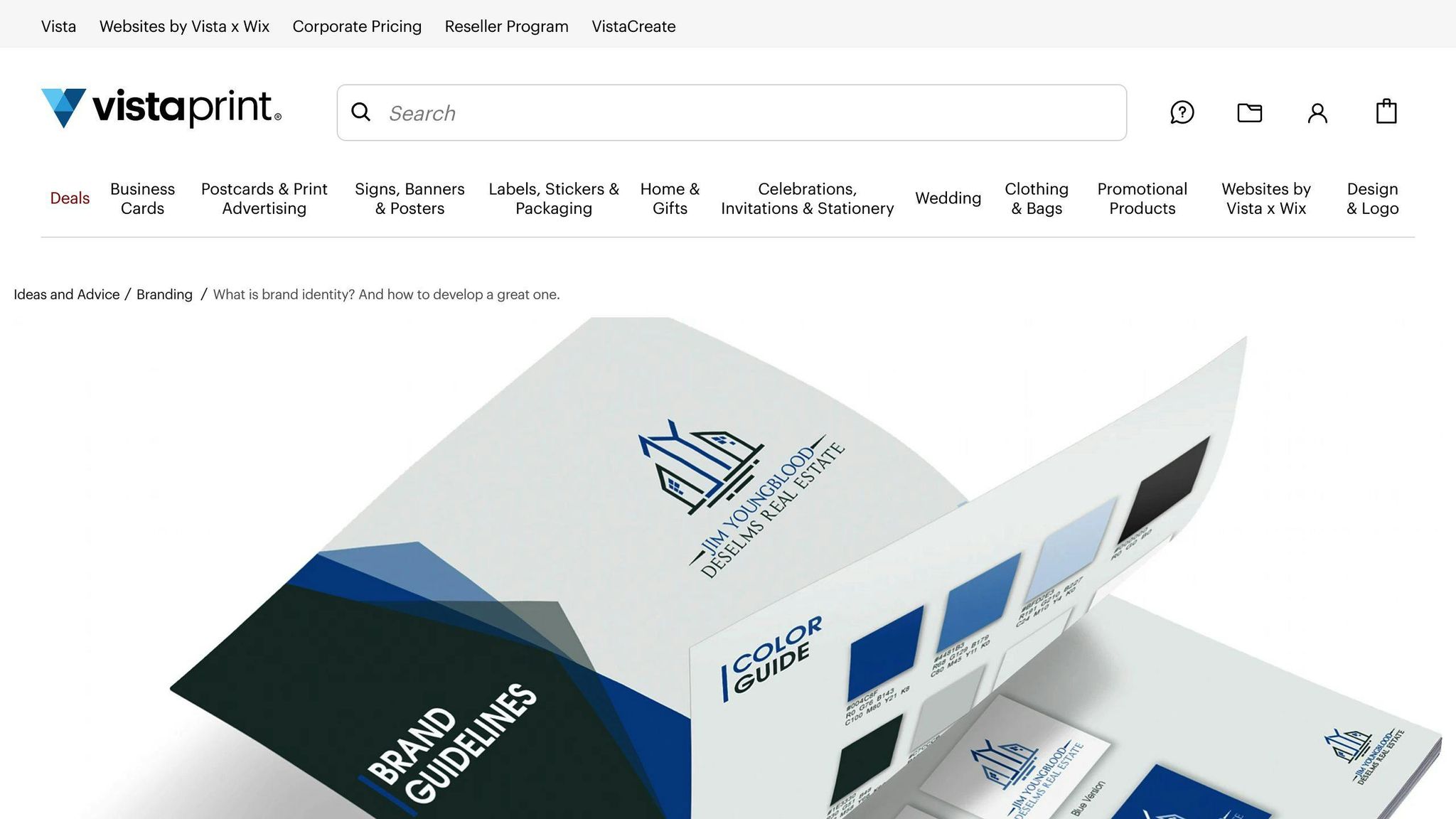Building a brand identity doesn't have to break the bank. Startups and SMEs can create a memorable brand presence using cost-effective strategies. Here's how:
- Understand Your Brand Identity: Know what your brand stands for visually and verbally.
- Use Free Design Tools: Tools like Canva can help create logos and design elements.
- Maximize Social Media: Platforms like Instagram and TikTok offer free ways to reach audiences.
- Leverage Content Marketing: Share your expertise through blogs and videos.
- Engage in Community and Networking: Connect with local or online communities relevant to your brand.
- Encourage User-Generated Content: Ask customers to share their experiences.
- Monitor and Adapt Based on Feedback: Use feedback to improve your brand strategy.
These steps can help you build a strong brand identity on a budget, making your business stand out and connect with the right audience.
Visual Brand Identity

The way your brand looks is a big deal. This includes your logo, the colors you use, the type of fonts, and the pictures that go with your brand. For instance, using bright colors and fun fonts might show you're a laid-back brand, while a simple design might say you're more upscale.
Here are some wallet-friendly ideas for your brand's look:
- Make your own logo with free online tools instead of paying a designer
- Find free photos on websites like Unsplash that fit your brand's vibe
- Choose 2-3 main colors to keep things simple and consistent
- Pick free fonts that match what your brand's personality
Verbal Brand Identity
How you talk about your brand matters too. This includes the words you use, your style, and even your catchphrases. It's all about how you communicate with people.
For small businesses, you should:
- Write a clear mission statement that shows what you're all about
- Keep a consistent way of talking across all your stuff, like your website and social media
- Use catchy words that are tied to what you sell to help people remember you
Brand Values
What your company stands for is also key. These are your brand values. They guide how you make decisions and can draw in customers who think the same way.
Here's how to figure out your values:
- Talk with your team leaders to nail down what's important to you
- Learn about your audience to see what values you share
- Be clear about your values everywhere you talk about your brand
- Act on your values in how you run things
Taking the time to nail down your brand identity helps people get, trust, and choose your brand more easily. And the good news is, you can do this even with a tight budget.
Cost-Effective Strategies for Building Your Brand Identity
1. Define Your Brand's Core
Start by figuring out what your brand is all about. This includes your main goals, who you want to reach, and what you stand for. You don't need to spend a lot of money. Just have some good talks with your team to make sure everyone understands what makes your brand special.
2. Leverage Free and Low-Cost Design Tools
Use free websites like Canva and Adobe Spark to make your logo and other cool stuff. Keeping the same look across everything, like colors and fonts, helps people recognize your brand better.
3. Maximize Social Media Impact
Post interesting stuff on social media that fits your brand's style and voice. Sites like Instagram and TikTok are great for getting more people to know about your brand without spending much.
4. Utilize Content Marketing
Share your knowledge through blogs, videos, and more. This shows you know your stuff and builds trust. Use the same content in different places to reach more people. Give helpful tips to keep your audience interested.
5. Engage in Community and Networking
Get involved in your local area or online communities that match your brand. This can help spread the word about your brand in a natural way. Join groups and talk to people who might like what you offer.
6. Encourage User-Generated Content
Ask your customers to share their experiences with your brand. This could be through contests or just asking for reviews. Seeing real people use and like your products makes others more likely to trust your brand.
7. Monitor and Adapt Based on Feedback
Use free tools to see how people are reacting to your brand online. Also, ask your customers what they think directly. If you find out something isn't working, don't be afraid to change things up.
Case Studies
Here are some real stories of small businesses and startups that made a strong presence without spending a lot of money:
Fizzy Bubble Tea
Fizzy Bubble Tea is a new bubble tea shop in Los Angeles. They didn't have a lot of money, but they knew they wanted to be known for making fresh, tasty bubble tea and offering great service.
They made a colorful and fun logo using Canva and shared great pictures of their bubble tea on Instagram. They also worked with local partners, social media influencers, and took part in community events to get the word out. In just one year, Fizzy Bubble Tea became really popular in LA thanks to their smart and low-cost marketing.
The Rustic Wood Co
The Rustic Wood Co makes eco-friendly wooden furniture. They wanted to be known as experts in making sustainable wood products. They did this by writing detailed blog posts about woodworking and being green.
Even with a small budget, they got noticed by big home decor websites by writing guest posts for free. They also built a community of fans who would talk about their brand by starting an affiliate program. This helped The Rustic Wood Co get a lot more visitors to their website and grow their email list a lot.
Appetite Log
Appetite Log is a SaaS startup that made an app for fitness fans to track their meals and nutrition. With hardly any money for marketing, they found potential users on social media by looking for specific hashtags. Then, they talked to these people by giving them useful tips on fitness and eating right.
They also asked their users to share their own stories about getting healthier, which made other people trust and like their brand. Even though they spent less than $500 on marketing, they got over 100,000 new users in less than a year.
These stories show that with good planning, being creative, and staying committed, small businesses and startups can create a brand identity that people remember and grow their business without needing a lot of money. The key is to really understand what your brand is about, use free ways to market yourself, and make content that speaks to your audience.
sbb-itb-5c5ac24
Conclusion
We've talked about how new businesses and small companies can create a strong brand without spending a lot of money. It's all about planning well, being creative, and sticking to it. Even with a small budget, it's possible to make a brand that stands out and tells everyone what you're about.
Here's a quick summary of the main points we covered:
- Know your brand inside out - Be clear about what you stand for, what makes you different, and why people should care. This is the starting point for all your branding work.
- Use free design tools - Websites like Canva let you make logos and other visuals for free. This helps you keep your look consistent without spending much.
- Get the most out of social media - Using sites like Instagram and TikTok can help more people learn about your brand without needing a lot of money.
- Share what you know - Writing articles or making videos can attract people to your brand because you're offering them something valuable.
- Join in with communities - Being part of groups that are relevant to your brand can spread the word about what you're doing naturally.
- Get your customers involved - When customers share their own stories or reviews, it makes your brand seem more trustworthy.
- Keep an eye on feedback - Watching what people say about your brand and adjusting based on that feedback can make your brand stronger.
The stories we shared show that with the right approach, even new and small brands can grow a lot without needing a big budget.
In the end, making a memorable brand is more about having good ideas and being dedicated than how much money you have. We hope this guide helps all new businesses and small companies out there to build brands that really show who they are and connect with the right people. If you need a hand with your brand, just let us know!
Related Questions
How do you create a brand identity for a startup?
Here's how to make your startup's brand stand out without spending a lot:
- First, figure out what your business stands for, who you're trying to reach, and what makes you different. This is your starting point.
- Use free online tools like Canva for designing your logo and picking your colors and fonts. Keep it simple but make sure people will remember it.
- Decide how you want to talk about your brand. This includes the style and special phrases you use. Make sure it's the same everywhere.
- Use social media to get people to notice and interact with your brand. Share stuff that's useful and interesting.
- Get your customers to talk about their experiences with your brand. This could be through fun contests or just asking for their thoughts. It helps build trust.
- Always check how your brand is doing and be ready to make changes if needed. See what people like and don't like.
The main idea is to know what makes your brand special and share that with the world, even if you're on a tight budget. Being creative and consistent can really make a difference.
How much does it cost to create a brand identity?
Creating a brand identity can cost:
- $0-100 if you do it yourself with free tools and resources.
- $1,500-5,000 if you hire freelancers for things like your logo, visuals, and writing.
- $3,000-15,000+ if you work with a small agency, depending on what you need them to do.
The more you need, like research or custom designs, the more it'll cost. But, startups can create a solid brand identity without spending a lot by using free resources and setting a budget for some professional help.
How do you create an effective brand identity?
To make an effective brand identity, try these steps:
- Research your audience and competitors without spending a lot.
- Decide what your business is all about and how you want to be seen.
- Design your logo and choose colors and fonts that people will remember, using free tools.
- Write your key messages in a way that's true to your brand.
- Make sure your brand looks and feels the same everywhere, from your website to ads.
- Use social media and community events to get people talking about your brand.
- Keep an eye on how people see your brand and be ready to tweak things.
The goal is to make sure your brand stands out and feels unique, even if you're just starting out.
How will you create an effective branding strategy in business?
Here's how to build a branding strategy that works:
1. Identify your target buyers - Learn about who they are and what they like.
2. Define your competitive difference - Explain why your business is different and better.
3. Craft consistent messaging - Make sure the way you talk about your brand matches your unique qualities.
4. Design visual assets - Create a logo and pick colors and fonts that show off your brand's personality.
5. Execute multi-channel outreach - Use your branding everywhere, like on your website, ads, and social media.
6. Encourage engagement and advocacy - Get people to share their own stories about your brand.
7. Track performance and refine - Keep an eye on what's working and adjust your strategy as needed.
The focus is on making your brand stand out to your customers by highlighting what makes you unique.



